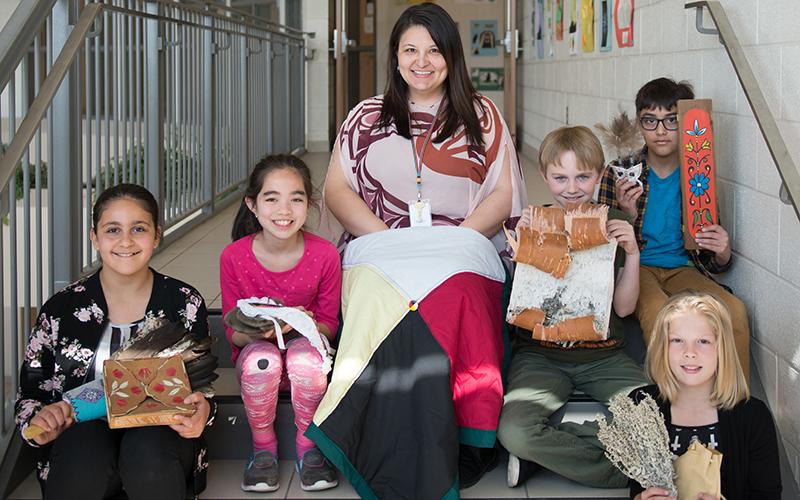
Teaching Indigenous Histories Through an Authentic Voice
As a mother and educator, all I seem to think about lately is the legacy we are leaving. What kind of future will our children have? What kind of stories will inspire them to live passionately and change the world? I want them to have a strong sense of environmental stewardship and ecological identity. I want them to be kind. I want them to understand the true history of Canada and her Indigenous peoples. But how can I change a national narrative – a narrative where, too often, an authentic understanding of Indigenous issues, peoples and their stories is missing. It is important to me that children know that Indigenous people in Canada are not just a people of the past with a tragic history. It’s important for our students to learn about the historical and current contributions made by the first peoples of this land.
In her 2009 Ted Talk, The Danger of a Single Story, Chimamanda Ngozi Adichie describes the importance of multiple narratives about groups of people. She reflects on times when she has been guilty of perpetrating a single story about other people, and when a single story has been told about her as a woman from Africa. She stresses the importance of telling many stories in many different voices to ensure that we get at the complexity and diversity of people’s experiences. “Stories matter. Many stories matter. Stories have been used to dispossess and malign. But stories can also be used to empower.” We have much to learn from people and their stories, the experiences they live and the challenges they overcome.
Many moons ago, when I was apartment hunting in university, I stumbled upon a lakefront rental. It was in Curve Lake First Nation, historically named the Mud Lake Reserve, just north of Peterborough. The house belonged to the late Elsie Knott. After I was settled in, I learned who Elsie was from her daughter Rita who is the Anishnaabomowin (Ojibwe language) teacher at the Curve Lake First Nation School. I eventually worked shoulder to shoulder with Rita in my very first teaching position and witnessed the children’s love of their once mother tongue.
Elsie Knott’s legacy should be a story we share with our students. She was a woman of humble beginnings. She spoke only Anishnaabomowin until the age of nine. She had only a Grade 8 education because kids in her community didn’t have access to a high school. The government didn’t fund education for “Indian” children past grade 8 in her day. This didn’t stop her though.
Growing up, her family was financially poor, but rich in spirit and determination. Her father was part of the band council, and she sat alongside him listening to her elders speak of the challenges her community faced. Later in life, she realized she wanted to make a difference. In 1954, Elsie became the first Indigenous woman to be a band chief in Canada. This was just a year after an “Indian woman” could vote in a band election, and six years before Indigenous people were granted the right to vote in a federal election.
In the late 1950’s, Elsie brought education to the children of her community. She started by driving children to school to the next town in a pickup truck. It couldn’t have been easy on that long winding unpaved road out of the village, especially in the winter. She eventually converted a funeral hearse to take the children to school. Not only did she transport students for 30 years, she went on to negotiate and raise funds to build a school and a church, and to pave the roads in her community, among other things. Elsie was a historical icon who empowered the people in her community for decades.
Elsie is part of a history of Indigenous women many of us don’t know. This history tells stories about perseverance, about trailblazing; it tells the stories of lawyers and environmentalists, artists, teachers, authors, human rights activists and many others.
In 2016, ETFO created a poster celebrating 21 First Nations, Métis and Inuit (FNMI) women for their contributions in arts, education, politics and environmental and human rights. There are seven First Nations women, seven Métis women, and seven Inuit women named in the poster, but there are many more that students could potentially research. As I was looking at this poster, I thought about using it as a teaching tool. Students could begin an inquiry project through a social justice lens exploring the work of women such as Dr. Cindy Blackstock. Through the First Nations Child and Family Caring Society of Canada, Dr. Blackstock has fought for the thousands of Indigenous children caught in Canada’s dysfunctional child welfare system. Students could research other women on the poster, such as environmentalist Sheila Watt-Cloutier, educator and spokesperson for Idle No More Dr. Pamela Palmater, visual artist Christie Belcourt or Inuit throat singer Tanya Tagaq Gillis.
Researching FNMI heros and heroines gives our students inspiration. Researching FNMI issues gives our students understanding. Students could explore why so many of Canada’s Indigenous children do not have access to education in their own community and have to move away from home to attend high school. They could explore why so many of Canada’s children still do not have access to clean drinking water. What is a water walk and why is it important? They could consider why so many young Indigenous children take their own lives or what stories Indigenous artists are telling us. As educators, we have a responsibility to expose our students to these stories, to encourage them to work towards reconciliation and a brighter future for all. Together we can learn not only about the issues but about the Indigenous people who have fought for change and made important contributions to the law, the environment, education, social justice and the arts. The children in our classrooms at this very moment are those who will take these stories, draw upon the inspiration and advocacy of our heroines and make a difference.
I wish I could write at great length about these 21 women. Maybe that will be a journey in your classroom one day. Start by looking around your classroom. Do you have Indigenous artwork or artifacts in your classroom? Are there Indigenous titles in your classroom library or on your bookshelf of professional resources? What stories will you share with your students?
In the Classroom
We know that authenticity is imperative for storytelling. I was in the staff room a few months ago, and a Grade 5 teacher I had never met started chatting with me. We decided I would visit his classroom weekly and talk about First Nation stuff. “Cool. I’m Ojibwe. I’ve taught Grade 5s before. I’ve got this,” I thought. I was so excited.
I started with the classic, ‘know, wonder, learn chart,’ and quickly realized that it’s hard for children to wonder about something in a meaningful way if they have very little background! I tried a couple of mini-history lessons and realized they were so dry I was boring myself.
Then I tried something different. I told my colleague I was going to change up my style and bring in some cultural artifacts. “Yes!” he said.
When I arrived, rather than having students sit at their desks with me at the front of the room, I laid out a beautiful four-colour medicine wheel table cloth on the floor. I asked the students to pull their chairs around the circle. I told them the importance of sitting in a circle, how we all become of equal importance. No one is in the front, and no one is at the back.
They sat quietly as I put down some sweetgrass and sage, porcupine quills, birch bark, my drum, my eagle feather and fan, and some beadwork.
I started by asking students to identify themselves by nation or by the language they speak. I mentioned that we have friends from Italy and Jamaica in our circle, friends who speak Arabic and French, and then I identified as Irish and Ojibwe. This is usually when FNMI students will self-identify by saying, “Oh I’m Ojibwe too,” or “I’m Mohawk!” We went around the circle and the students shared things about their language or special music or cultural foods they enjoy in their home. I asked them to share part of who they are, part of their story. Then I continued with mine. I talked about how I love to paint and sing and kayak. I mentioned I wasn’t a good singer, but that I do like to sing lullabies to my baby. I sang them the Water Song, and asked them to join in. They caught on quickly; two students had heard the song before. I told them that I love to bead, and I passed around my beadwork. I told them I was a jingle dancer and showed them some videos on the smartboard. They asked questions, and I promised one day I would teach them how to bead. Then I gave them each a piece of birch bark and asked them to peel it. After determining that no one was allergic to birch, I showed them how to bite it and make images with their teeth. Some of them made fish, and some of them said they made Pokemon. I told them this was the ancient art form of birch bark biting, which is still practiced today. We talked about how Indigenous people are not just a “people of the past.” The students were genuinely interested and asked meaningful questions.
This process of sitting in a circle and sharing an authentic perspective with students sparked further inquiry. For weeks after, the kids stopped me in the halls asking questions and begging for more. It truly warmed my heart. It was also heartwarming to hear my colleague say, “Thank you for taking a risk.”
As I reflected on my brief but fun time in the Grade 5 classroom, I thought about the danger a single story could have created in that classroom. I could have left the students with a single narrative. I could have walked away and not dealt with their burning questions, one of which was, “Why does it matter what you are called anyway?” By bringing in stories children can connect to, powerful things can happen. Powerful stories can be told, stories that shape their future.
Taking the Plunge
If you’re still reading, congratulations. You are ready to take the plunge. Take a risk. Introduce your students to a story about Canada, one that may have frightened you to talk about in the past. Perhaps you’re worried you’ll get it wrong, or say the wrong thing. Journey with your students, and empower them to take their own risks. Teach them that all people have many stories that make up their identities, that help them not only look into their histories but also look toward their futures.
If you’re looking for a place to start, visit ETFO’s spirithorse website. Spirithorse.ca has a magnitude of authentic resources to get you and your students started on your storytelling journey.
Finally, as the school year comes to an end, celebrate National Aboriginal Day on June 21st. Let your students decide how to celebrate. Let your students guide their inquiry. Let your students learn about the rich culture our Indigenous peoples in Canada have. And don’t forget to tell them about your learning journey and share your story along the way. Baamaapii (until we talk later).
Tanya C. Leary is Sealteaux First Nation, and a member of the Hamilton-Wentworth Teacher Local.

